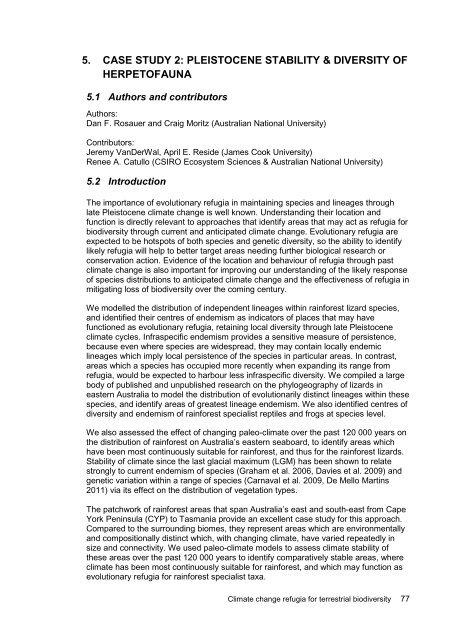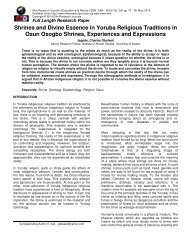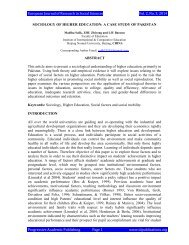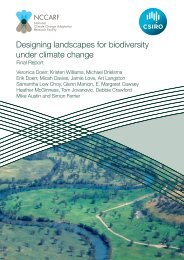Williams-Climate-change-refugia-for-terrestrial-biodiversity_0
Williams-Climate-change-refugia-for-terrestrial-biodiversity_0
Williams-Climate-change-refugia-for-terrestrial-biodiversity_0
You also want an ePaper? Increase the reach of your titles
YUMPU automatically turns print PDFs into web optimized ePapers that Google loves.
5. CASE STUDY 2: PLEISTOCENE STABILITY & DIVERSITY OF<br />
HERPETOFAUNA<br />
5.1 Authors and contributors<br />
Authors:<br />
Dan F. Rosauer and Craig Moritz (Australian National University)<br />
Contributors:<br />
Jeremy VanDerWal, April E. Reside (James Cook University)<br />
Renee A. Catullo (CSIRO Ecosystem Sciences & Australian National University)<br />
5.2 Introduction<br />
The importance of evolutionary <strong>refugia</strong> in maintaining species and lineages through<br />
late Pleistocene climate <strong>change</strong> is well known. Understanding their location and<br />
function is directly relevant to approaches that identify areas that may act as <strong>refugia</strong> <strong>for</strong><br />
<strong>biodiversity</strong> through current and anticipated climate <strong>change</strong>. Evolutionary <strong>refugia</strong> are<br />
expected to be hotspots of both species and genetic diversity, so the ability to identify<br />
likely <strong>refugia</strong> will help to better target areas needing further biological research or<br />
conservation action. Evidence of the location and behaviour of <strong>refugia</strong> through past<br />
climate <strong>change</strong> is also important <strong>for</strong> improving our understanding of the likely response<br />
of species distributions to anticipated climate <strong>change</strong> and the effectiveness of <strong>refugia</strong> in<br />
mitigating loss of <strong>biodiversity</strong> over the coming century.<br />
We modelled the distribution of independent lineages within rain<strong>for</strong>est lizard species,<br />
and identified their centres of endemism as indicators of places that may have<br />
functioned as evolutionary <strong>refugia</strong>, retaining local diversity through late Pleistocene<br />
climate cycles. Infraspecific endemism provides a sensitive measure of persistence,<br />
because even where species are widespread, they may contain locally endemic<br />
lineages which imply local persistence of the species in particular areas. In contrast,<br />
areas which a species has occupied more recently when expanding its range from<br />
<strong>refugia</strong>, would be expected to harbour less infraspecific diversity. We compiled a large<br />
body of published and unpublished research on the phylogeography of lizards in<br />
eastern Australia to model the distribution of evolutionarily distinct lineages within these<br />
species, and identify areas of greatest lineage endemism. We also identified centres of<br />
diversity and endemism of rain<strong>for</strong>est specialist reptiles and frogs at species level.<br />
We also assessed the effect of changing paleo-climate over the past 120 000 years on<br />
the distribution of rain<strong>for</strong>est on Australia’s eastern seaboard, to identify areas which<br />
have been most continuously suitable <strong>for</strong> rain<strong>for</strong>est, and thus <strong>for</strong> the rain<strong>for</strong>est lizards.<br />
Stability of climate since the last glacial maximum (LGM) has been shown to relate<br />
strongly to current endemism of species (Graham et al. 2006, Davies et al. 2009) and<br />
genetic variation within a range of species (Carnaval et al. 2009, De Mello Martins<br />
2011) via its effect on the distribution of vegetation types.<br />
The patchwork of rain<strong>for</strong>est areas that span Australia’s east and south-east from Cape<br />
York Peninsula (CYP) to Tasmania provide an excellent case study <strong>for</strong> this approach.<br />
Compared to the surrounding biomes, they represent areas which are environmentally<br />
and compositionally distinct which, with changing climate, have varied repeatedly in<br />
size and connectivity. We used paleo-climate models to assess climate stability of<br />
these areas over the past 120 000 years to identify comparatively stable areas, where<br />
climate has been most continuously suitable <strong>for</strong> rain<strong>for</strong>est, and which may function as<br />
evolutionary <strong>refugia</strong> <strong>for</strong> rain<strong>for</strong>est specialist taxa.<br />
<strong>Climate</strong> <strong>change</strong> <strong>refugia</strong> <strong>for</strong> <strong>terrestrial</strong> <strong>biodiversity</strong> 77






